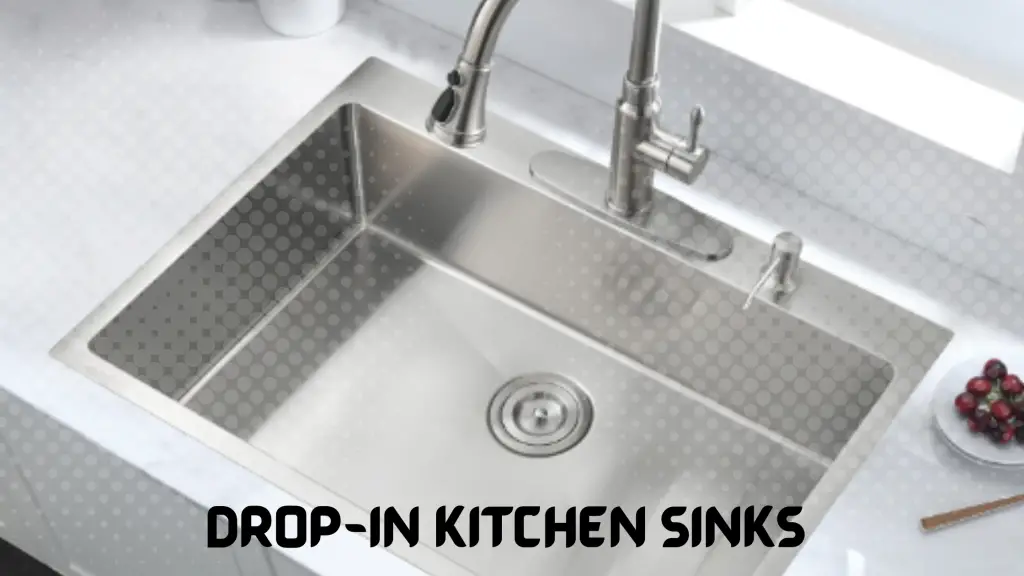
A self-rimming or drop-in kitchen sink fits into a hole drilled through the countertop while sitting on top of the countertop. These sinks are well-liked since they are simple to install and flexible in design and size. This article will examine drop-in kitchen sinks in further detail, including their buying guides, advantages and disadvantages, and installation and upkeep advice.
What is Drop-In Kitchen Sinks?
A Drop-In Sink: This is a Kitchen sink that is installed and sits on top of your kitchen counter. It is also called a self-rimming sink, overmount sink or top-mount sink. On the outside of the basin, right above the cut-out for the sink, there is an apparent rim or lip. Here are examples of common sinks, drop-in kitchen sink by size, drop-in kitchen sinks with single bowls; drop-in kitchen sinks with no holes; and drop-in kitchen sink with drainboards.
Types of Drop-In Sinks
There are several types of drop-in sinks to choose from, including:
- Stainless steel: These sinks are well-liked for their robustness and resistance to scratches and stains. They are available in various shapes and sizes and may be a fantastic option for conventional and contemporary kitchen designs.
- Porcelain: A ceramic material called vitreous china is used to create porcelain sinks. They are renowned for being stain-resistant and easy to maintain, but they can also be more delicate than other materials. They are a popular option for many homes since they are available in various hues and patterns.
- Acrylic: Acrylic sinks are available in a wide range of hues and patterns, are lightweight, and are simple to install. They could be cost-effective but might need to be stronger than other materials.
- Solid surface: Granite, quartz, and synthetic materials make solid surface sinks. They are renowned for their dependability, heat and stain resistance, and ease of care. Although they might cost more than other materials, they come in various hues and patterns.
Pros and Cons of Drop-In Sinks
Pros:
- Easy to install: Drop-in sinks are easy to install, making them a fantastic option for do-it-yourselfers or those on a tight budget.
- Versatile: They are appropriate for every kitchen because they are available in various materials, sizes, and designs.
- Affordable: These sinks may be more affordable than other sink kinds.
Cons:
- Harder to Clean: It may be more complex than other sinks since the sink’s rim stands over the countertop.
- Style: Drop-in sinks may not work well with modern kitchen designs since they seem more dated.
Installation and Maintenance
You may install a drop-in sink relatively quickly, but it’s crucial to use the right equipment and adhere to the manufacturer’s instructions. The main procedures for installing a drop-in sink are as follows:
- To ensure the sink will fit properly, measure the hole in the countertop.
- Ensure the sink is level and centered before placing it on the countertop.
- Use the manufacturer’s supplied clamps and glue to fix the sink in place.
- As directed by the manufacturer, connect the plumbing.
Maintenance
- Use a light detergent and give the sink a good rinse after each use to maintain it clean as part of routine maintenance.
- You can use a moderate acid solution to remove hard water stains.
- You should not use abrasive cleaning supplies since they might scrape and harm the sink.
Drop-in sinks are a fantastic choice for homeowners seeking a flexible, simple-to-install sink that may match a range of kitchen designs. There is a drop-in sink to fit every style and price range, thanks to various materials available, including stainless steel, porcelain, acrylic, and solid surface. Choosing to fit your lifestyle requires considering the possible cleaning difficulties associated with drop-in sink design.
Drop-In vs. Undermount Sinks
Is a drop-in or undermount kitchen sink better? Kitchen sinks, whether drop-in or undermount, each offer advantages, and disadvantages. The most typical and straightforward to install are drop-in sinks. They feature a lip extending over the counter’s edge and rest on the surface to hold the sink in place. They are also the most affordable choice.
On the other hand, undermount sinks have no lip and are placed beneath the counter. Since there is no lip for food and debris to settle on, they appear seamless and are simpler to clean. However, they are more costly and sometimes more difficult to install than drop-in sinks. Therefore, deciding between a drop-in and an undermount sink will ultimately come down to preference and price.
What is the difference between drop-in and dual-mount sinks?
Dual-mount sinks and drop-in sinks can be installed using the same technique, with a lip extending over the counter’s edge to secure the sink in place. The primary distinction between the two is the possibility of installing a dual-mount sink as an undermount sink.
With pre-drilled holes on the bottom, you may put a dual-mount sink beneath the counter for a smooth appearance and simpler cleaning.
On the other hand, a drop-in sink can only be placed with the lip resting on top of the counter. Although more installation choices are available with dual-mount sinks, drop-in sinks are often more costly.
Are drop-in sinks outdated?
Drop-in sinks are still a common choice among homeowners and contractors, so they are not necessarily outdated. They come in various forms and patterns, are inexpensive, and are simple to install. Drop-in sinks may be fitted in several countertop materials, including laminate, solid surface, granite, and more. They are also adaptable. The appearance and ease of installation, maintenance, and repair in the event of damage are still preferred by many individuals.
Although drop-in sinks are still a fantastic option for people who appreciate the aesthetic and convenience of installation, undermount sinks, which are growing in popularity, can be seen as more contemporary. The decision between an undermount and a drop-in sink will ultimately come down to personal preference,
How are drop-in sinks supported?
The mounting clips attached to the sink and fastened into the countertop, as well as the lip extending over the edge of the counter, support drop-in sinks. The mounting clamps also stabilize the sink, while the sink’s lip is a barrier and holds it in place.
When installing a drop-in sink, a hole is cut into the countertop to match the sink’s size and form. After that, the sink is lowered into the opening, so its lip rests on the counter. Next, using pre-drilled holes on the sink, mounting clips are fastened to the sink and into the countertop. These clamps aid in stabilizing the sink’s position and preventing movement or shifting.
It’s crucial to remember that the countertop needs to be adequately strengthened to handle the sink’s weight and the water it contains. The clips must also be snug enough to keep the sink in place but not too tight to split the countertop or sink.
Conclusion
It’s always advisable to adhere to the manufacturer’s installation instructions and have a licensed plumber handle the plumbing components. However, even if they can do it themselves, many homeowners hire a professional to install the sink to ensure it is fitted correctly and prevent any leaks or damage to the sink or countertop.
Last but not least, it’s critical to maintain your drop-in sink properly by keeping it clean and avoiding harsh cleaning supplies. Your sink may survive for many years with a regular cleaning schedule and timely treatment of any issues, such as leaks. A drop-in sink may be a fantastic option for any kitchen with the proper care and upkeep.

